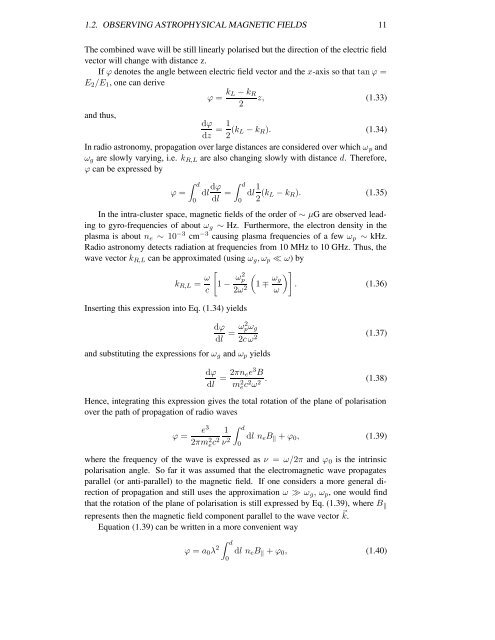Investigations of Faraday Rotation Maps of Extended Radio Sources ...
Investigations of Faraday Rotation Maps of Extended Radio Sources ...
Investigations of Faraday Rotation Maps of Extended Radio Sources ...
You also want an ePaper? Increase the reach of your titles
YUMPU automatically turns print PDFs into web optimized ePapers that Google loves.
1.2. OBSERVING ASTROPHYSICAL MAGNETIC FIELDS 11<br />
The combined wave will be still linearly polarised but the direction <strong>of</strong> the electric field<br />
vector will change with distance z.<br />
If ϕ denotes the angle between electric field vector and the x-axis so that tan ϕ =<br />
E 2 /E 1 , one can derive<br />
ϕ = k L − k R<br />
z, (1.33)<br />
2<br />
and thus,<br />
dϕ<br />
dz = 1 2 (k L − k R ). (1.34)<br />
In radio astronomy, propagation over large distances are considered over which ω p and<br />
ω g are slowly varying, i.e. k R,L are also changing slowly with distance d. Therefore,<br />
ϕ can be expressed by<br />
ϕ =<br />
∫ d<br />
0<br />
dl dϕ ∫ d<br />
dl = dl 1 2 (k L − k R ). (1.35)<br />
In the intra-cluster space, magnetic fields <strong>of</strong> the order <strong>of</strong> ∼ µG are observed leading<br />
to gyro-frequencies <strong>of</strong> about ω g ∼ Hz. Furthermore, the electron density in the<br />
plasma is about n e ∼ 10 −3 cm −3 causing plasma frequencies <strong>of</strong> a few ω p ∼ kHz.<br />
<strong>Radio</strong> astronomy detects radiation at frequencies from 10 MHz to 10 GHz. Thus, the<br />
wave vector k R,L can be approximated (using ω g , ω p ≪ ω) by<br />
k R,L = ω [<br />
1 − ω2 (<br />
p<br />
c 2ω 2 1 ∓ ω ) ]<br />
g<br />
. (1.36)<br />
ω<br />
Inserting this expression into Eq. (1.34) yields<br />
and substituting the expressions for ω g and ω p yields<br />
0<br />
dϕ<br />
dl = ω2 pω g<br />
2c ω 2 (1.37)<br />
dϕ<br />
dl = 2πn ee 3 B<br />
m 2 ec 2 ω 2 . (1.38)<br />
Hence, integrating this expression gives the total rotation <strong>of</strong> the plane <strong>of</strong> polarisation<br />
over the path <strong>of</strong> propagation <strong>of</strong> radio waves<br />
ϕ =<br />
e 3 ∫<br />
1 d<br />
2πm 2 e c2 ν 2<br />
0<br />
dl n e B ‖ + ϕ 0 , (1.39)<br />
where the frequency <strong>of</strong> the wave is expressed as ν = ω/2π and ϕ 0 is the intrinsic<br />
polarisation angle. So far it was assumed that the electromagnetic wave propagates<br />
parallel (or anti-parallel) to the magnetic field. If one considers a more general direction<br />
<strong>of</strong> propagation and still uses the approximation ω ≫ ω g , ω p , one would find<br />
that the rotation <strong>of</strong> the plane <strong>of</strong> polarisation is still expressed by Eq. (1.39), where B ‖<br />
represents then the magnetic field component parallel to the wave vector ⃗ k.<br />
Equation (1.39) can be written in a more convenient way<br />
∫ d<br />
ϕ = a 0 λ 2 dl n e B ‖ + ϕ 0 , (1.40)<br />
0
















